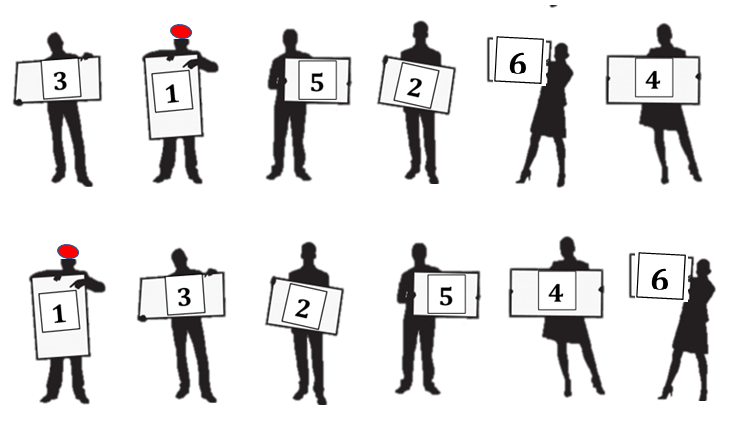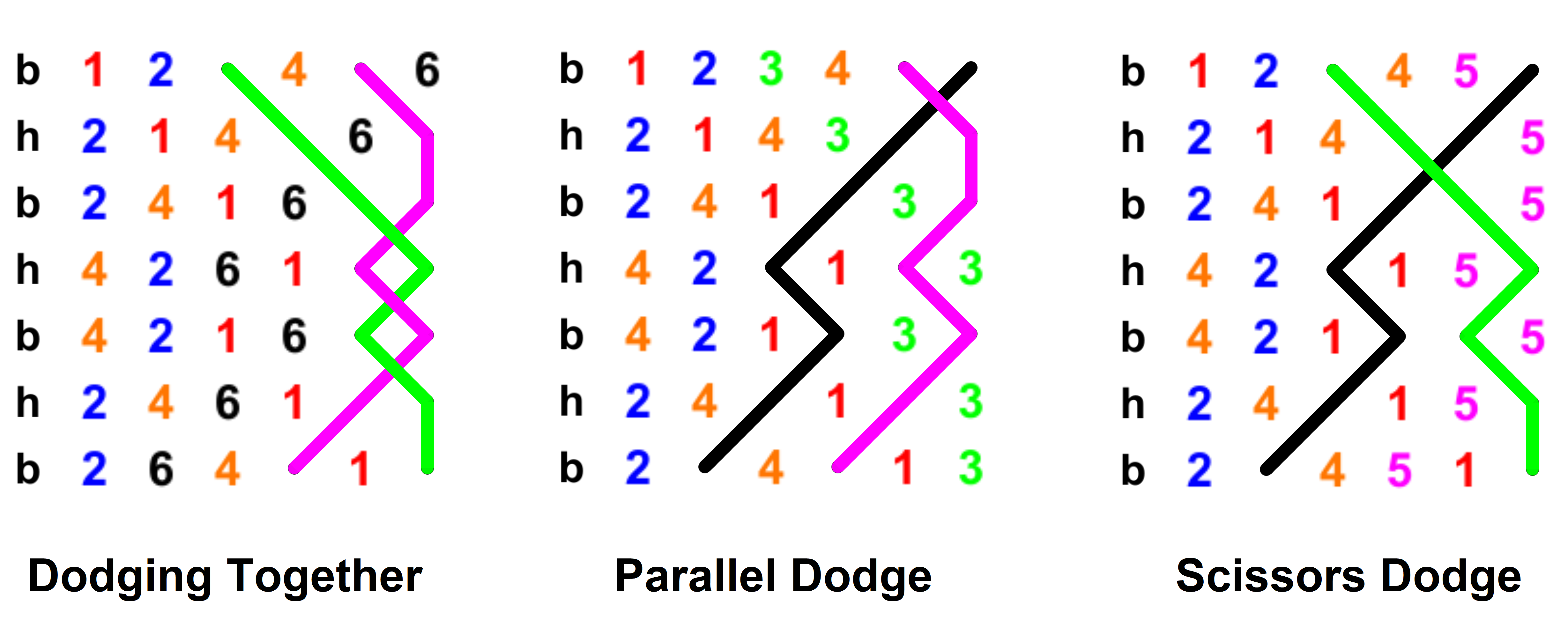Plain Bob Minor
What is Plain Bob Minor?
You have already learnt and rung Plain Hunt on six bells and learnt the three handbell positions – coursing, opposites and the 2/3 position. The first method that you go on to ring will be Plain Bob Minor. Let's now look at how Plain Bob Minor works, sometimes known as its structure or place notation.
The good news is that Plain Bob Minor is mainly Plain Hunt. It is only when the treble leads that something different happens – a place (seconds place) is made over the treble for two blows causing the bells above this, in 3/4 and 5/6 to dodge. This happens for five leads in total and then the bells come round.
Let's assume you can plain hunt competently and let's pick up plain hunt just before the treble leads. What happens?

Now, if we were ringing Plain Hunt this row would be followed by places being made in 1 and 6 (lead and lie) causing the middle bells to cross and the next row would be rounds - 1 2 3 4 5 6. Instead in Plain Bob places are made in 1 and 2 and the bells in 3/4 and 5/6 cross which results in a dodge.

Note that a bell (in this case the 3) leads, makes seconds over the treble and leads again. In the plain course each bell makes seconds over the treble once.
The above changes could be written as:
X X X
I I X X
X X X
How can we ring this thing called Plain Bob Minor on handbells? Happily it is easier than it sounds. You ring Plain Hunt until you reach the lead end (when the treble leads). At this change seconds place is made rather than sixth place. You make a shape and pick up a new position – coursing, opposites or the 2/3 position. If both hands do the same work the pattern doesn’t change.
Reach for your squared paper and two different coloured pens. Write out the plain course for your chosen pair of bells.
Parallel and Scissor Dodges
Success in learning to ring handbells is to ring your bells as a pair, learning patterns, rather than as two blue lines. One of the first patterns you'll learn after hunting is the three ways that bells can dodge at the same time.

Dodging together
Two bells meet, dodge with each other and then part. You may get confused knowing when to part. In Plain Bob Minor (and all other right-place methods) you part on the backstroke. At the beginning you might want to learn the manoeuvre as "meet, cross, cross back for the dodge, cross again and part". Eventually knowing when to part will become automatic.
Parallel dodge
This is probably the easiest dodging pattern to ring as the bells ring in parallel. The dodge disrupts just one blow of the plain hunting pattern, when both bells step backwards for the dodge at backstroke.
Scissors dodge
This is the hardest dodging pattern to learn and confusion can arise knowing when the dodge is finished. Again, you may wish to learn this manoeuvre as "cross, part, meet, and then part".
Plain Bob Minor on six bells
Ring plain hunt until the treble leads. At the lead end, seconds is made and the bells in 3-4 and 5-6 dodge. The pairs of bells may change to new hunting positions. At the backstroke of the lead end, work out in which position you are striking your bells – coursing, opposites or 2/3 – and continue ringing this position until the next lead end.
The three different positions are uniquely defined. For example if you find yourself striking in 1st and 6th place of the change then you are in opposites and if you strike 3rd and 6th then you are in the 2/3 position. There is never 3rd and 6th in coursing. If you strike 2nd and 4th you are definitely coursing – there is no choice.
If you are not ringing the trebles you will need to practise the dodges at the lead end – you can dodge with yourself, parallel dodge or make a scissors dodge.
Plain Bob Minor on the Trebles (1-2)
Some people like to start ringing Plain Bob Minor on the trebles because it is obvious when the treble is leading as you are ringing it yourself. During a plain course however, it will ring all three plain positions and will change position at every lead end. You need to know your positions and everyone else is relying on you keeping the treble right.
Plain Bob Minor on the Tenors (5-6)
The majority of new handbell ringers start by ringing the tenors. In the plain course the tenors stay coursing except for one lead in which they ring the 2-3 position.
Plain Bob Minor on 3-4
Crib sheets
» Plain Bob Minor
Method Structure
Once a ringer has mastered Plain Hunt they are able to ring the block (x16), but what does this piece of place notation mean?
The x (cross) means that all bells on their up stroke swap positions in pairs 1-2, 3-4 and 5-6 so if they have come down in 2 they go up in 1 and if they have come down in 3 they go up in 4. The 16 indicates that places are made in 1 and 6. These places are made on the down stroke so the bells that go up in 1 and 6 place come down in the same position, whilst the other bells have to move so they swap in positions 2-3 and 4-5. This continues until the treble leads again and at the backstroke the bells sound rounds. If you find this a bit confusing, why not get out a piece of lined or graph paper and write out the grid using the place notation - x16
» More about place notation
In order to generate more changes (different music) whenever the treble leads instead of swapping the middle 2 pairs (2/3 & 4/5) we can swap the pairs in 3/4 and 5/6, and both bells in first and seconds place will stay in the same place for the backstroke that they were at the handstroke. This creates new features, a place is made internally in seconds place over the treble and the bells in 3/4 and 5/6 dodge. We have introduced a new block (x12). This lead and lead end can be repeated four times producing Plain Bob Minor.